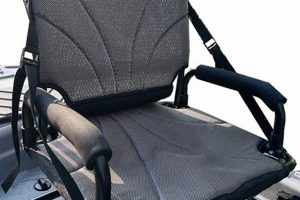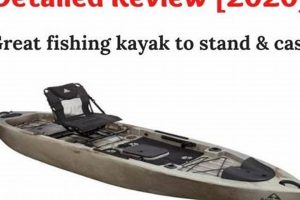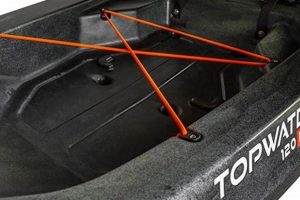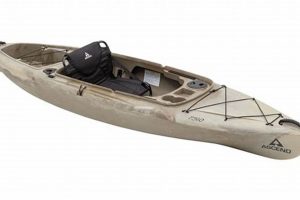Essential equipment for angling from a kayak enhances safety, improves fishing success, and provides a more comfortable experience on the water. This specialized equipment addresses the unique challenges and opportunities presented by fishing from a small, human-powered vessel. For example, specialized rods, reels, and tackle storage solutions cater to limited space and mobility, while safety gear like personal flotation devices and communication tools are vital for navigating often remote aquatic environments.
The evolution of specialized angling equipment for kayaks reflects the growing popularity of this sport. Prioritizing appropriate gear allows anglers to access shallow waters and secluded fishing spots often unreachable by larger boats. Furthermore, the correct equipment contributes significantly to angler safety and preparedness for unforeseen circumstances, highlighting the importance of careful selection and proper usage.
The following sections will explore the specific categories of essential kayak fishing equipment in detail, covering safety gear, fishing tackle, and organizational accessories. Each category will be analyzed to provide a comprehensive understanding of its role in successful and safe kayak fishing.
Essential Kayak Fishing Equipment Tips
Optimizing equipment selection and usage significantly impacts fishing success and safety. Careful consideration of the following recommendations will enhance on-the-water experiences.
Tip 1: Prioritize Safety Gear. A personal flotation device (PFD) is paramount. Choose a comfortable, fishing-specific PFD with ample pocket storage. A whistle, signaling mirror, and communication device (e.g., waterproof VHF radio or cell phone in a dry bag) are also essential safety components.
Tip 2: Select Appropriate Rods and Reels. Shorter rods (6-7 feet) are ideal for kayak fishing, offering maneuverability within a confined space. Consider rod holders designed for kayak mounting for hands-free storage and trolling. Select reels appropriate for the target species.
Tip 3: Organize Tackle Efficiently. Utilize waterproof tackle boxes and storage solutions designed specifically for kayaks. Prioritize frequently used lures and tackle to minimize clutter and maximize accessibility. Consider a crate or container system for organized storage behind the seat.
Tip 4: Choose a Stable and Comfortable Kayak. Kayak stability significantly impacts casting and landing fish. Consider a sit-on-top design for enhanced stability and ease of re-entry in case of a capsize. Adequate legroom and a comfortable seat are crucial for extended fishing trips.
Tip 5: Employ a Kayak-Specific Anchor. A lightweight, deployable anchor system prevents drifting and maintains position in desired fishing areas. An anchor trolley system allows for adjustments based on wind and current.
Tip 6: Utilize Fish Finders and GPS. A fish finder identifies underwater structures and fish locations, while a GPS unit aids navigation and marks productive fishing spots. Consider integrated units designed for kayak mounting.
Tip 7: Protect Gear from the Elements. Saltwater and sun exposure can damage equipment. Rinse gear thoroughly with freshwater after each trip and store it in a protected area. Apply UV protectant to plastics and composites.
Adhering to these guidelines contributes to a safer, more efficient, and ultimately more rewarding kayak fishing experience. The careful selection and proper utilization of essential equipment are key to success on the water.
The following section will summarize key takeaways and provide final recommendations for embarking on kayak fishing adventures.
1. Personal Flotation Device (PFD)
A Personal Flotation Device (PFD), commonly known as a life jacket, stands as a cornerstone of essential kayak fishing equipment. Its inclusion is not merely a recommendation, but a critical safety imperative. Kayak fishing, while rewarding, presents inherent risks, including capsizing, unexpected weather changes, and potential collisions. A PFD mitigates these risks by providing essential buoyancy, increasing the likelihood of survival in the event of an emergency. For instance, an angler unexpectedly encountering strong currents or a sudden wave could be easily capsized. A PFD ensures they remain afloat, significantly increasing their chances of self-rescue or rescue by others.
Beyond its life-saving function, a properly fitted PFD contributes to overall comfort and fishing effectiveness. Modern fishing-specific PFDs feature designs that prioritize mobility and functionality. Integrated pockets, attachment points, and specialized compartments allow anglers to carry essential tools, fishing accessories, and communication devices readily at hand. This streamlines the fishing process, reducing clutter and enhancing efficiency. Further, specialized PFDs are designed to minimize interference with casting motions, contributing to a smoother, more productive fishing experience.
Choosing the correct PFD is crucial. Inherent buoyancy levels vary, with Type III PFDs commonly recommended for kayak fishing. These offer sufficient flotation and flexibility for paddling and casting. Ensuring a proper fit and understanding how to correctly don and adjust the device are equally critical. Regular inspection of the PFD for wear and tear is essential for maintaining its effectiveness. Ultimately, integrating a PFD into kayak fishing practices represents a fundamental commitment to safety and responsible angling, ensuring a more secure and enjoyable experience on the water.
2. Paddle/Leash
Within the realm of essential kayak fishing equipment, the paddle and its accompanying leash represent fundamental components directly impacting safety and efficient angling. A paddle facilitates navigation and precise boat control, while a leash ensures its retention in dynamic on-water environments. Overlooking these seemingly simple tools can significantly compromise both fishing success and personal safety.
- Propulsion and Maneuverability
The paddle serves as the primary means of propulsion and maneuvering a kayak. Efficient paddling technique enables anglers to reach desired fishing locations, navigate currents and wind, and maintain precise boat positioning for optimal casting. Paddle choice influences performance; factors such as blade shape, shaft length, and material composition affect paddling efficiency and comfort. For example, a shorter paddle with wider blades offers greater power for maneuvering in tight spaces, while a longer, narrower blade provides efficient long-distance paddling.
- Leash Retention and Safety
A paddle leash provides a crucial safety link between the angler and their primary mode of propulsion. Unexpected events, such as a sudden wave or a strong gust of wind, can easily dislodge a paddle from the kayak. Without a leash, retrieving a lost paddle becomes a challenging, potentially dangerous endeavor. The leash ensures the paddle remains accessible, preserving maneuverability and preventing a potentially hazardous situation. This is particularly critical in open water or challenging weather conditions.
- Paddle Choice and Kayak Compatibility
Paddle selection should align with the kayak’s design and the angler’s physical attributes. Kayak width influences ideal paddle length, while factors like angler height and arm span determine comfortable shaft dimensions. Choosing a paddle tailored to these parameters optimizes paddling efficiency and reduces strain during extended fishing trips. For example, a wider kayak requires a longer paddle for effective strokes, while a narrower kayak benefits from a shorter paddle.
- Leash Types and Attachment Methods
Various paddle leash designs exist, each offering advantages and disadvantages. Coiled leashes offer flexibility and minimal interference with paddling strokes, while straight leashes provide a more direct connection. Secure attachment points on both the paddle and the kayak are crucial for leash effectiveness. Inspecting the leash regularly for wear and tear is essential for maintaining its reliability.
The paddle and leash, while often overlooked, represent fundamental components of essential kayak fishing gear. Proper paddle selection and consistent leash usage contribute significantly to safety, efficient on-water navigation, and ultimately, a more successful and enjoyable fishing experience. Integrating these seemingly simple tools into standard practice represents a commitment to responsible kayak angling and enhances overall on-the-water preparedness.
3. Rods/Reels
Rods and reels constitute essential components within the broader context of kayak fishing gear. Their specialized characteristics directly influence angling effectiveness and overall experience in this unique fishing environment. The confined space and dynamic nature of kayak fishing necessitate specific rod and reel choices distinct from those employed in traditional boat or shore fishing. Cause and effect relationships between rod/reel selection and fishing outcomes are readily apparent. For example, a shorter, more maneuverable rod (typically 6-7 feet) proves advantageous within the limited confines of a kayak, facilitating casting accuracy and fish fighting control. Conversely, a longer rod, ideal for shore casting, becomes cumbersome and impractical in a kayak setting. Similarly, reel choice must align with target species and fishing techniques. A lightweight spinning reel with a smooth drag system proves versatile for various species and presentations, while a baitcasting reel offers increased power and control for targeting larger fish.
The importance of rod and reel selection as components of essential kayak fishing gear is underscored by practical considerations. Specialized rod holders designed for kayak mounting enhance organization and accessibility, keeping rods secure and readily available while maintaining a clutter-free cockpit. Furthermore, rod and reel choices influence lure presentation and fishing technique. Lighter rods and reels excel with finesse presentations for smaller species, while heavier setups cater to larger lures and stronger fish. For example, targeting panfish in shallow water necessitates a lighter, more sensitive setup than pursuing offshore species requiring heavier tackle and robust drag systems. Understanding these nuances enables anglers to optimize their equipment choices, directly impacting fishing success and overall enjoyment.
In summary, appropriate rod and reel selection represents a critical aspect of successful kayak fishing. The confined space and dynamic nature of kayak angling necessitate specialized equipment choices that prioritize maneuverability, efficiency, and compatibility with target species. Recognizing the direct impact of rod and reel selection on fishing outcomes and overall experience underscores the importance of informed decision-making. This understanding empowers anglers to optimize their equipment choices, contributing significantly to a more productive, enjoyable, and safe kayak fishing experience. The subsequent sections will delve into other essential gear categories, building upon the foundation established by the crucial role of rods and reels.
4. Tackle Storage
Effective tackle storage stands as a critical component within the essential gear ensemble for kayak fishing. Its significance stems from the limited space and dynamic environment inherent to kayak angling. Organized and accessible tackle storage directly influences fishing efficiency and safety, enabling anglers to quickly locate necessary items without compromising stability or focus. Disorganized tackle, conversely, can lead to frustration, wasted time, and potentially hazardous situations in a setting where balance and situational awareness are paramount.
- Space Optimization
Kayaks offer limited storage compared to traditional fishing boats. Effective tackle storage solutions maximize available space through compact, specialized designs. Tackle boxes with customizable compartments, waterproof bags, and purpose-built kayak crates represent examples of space-saving strategies. These systems ensure efficient use of limited storage areas, keeping essential gear organized and readily accessible.
- Accessibility and Efficiency
Rapid access to lures, hooks, and other terminal tackle is crucial for maintaining fishing momentum. Well-organized tackle storage facilitates quick retrieval of necessary items, minimizing time spent searching and maximizing time spent fishing. For example, labeling compartments or utilizing clear storage containers allows for immediate identification of contents, streamlining the process of changing lures or re-rigging.
- Environmental Protection
Kayak fishing exposes tackle to the elements, including water, sun, and potentially extreme temperatures. Waterproof and UV-resistant storage solutions protect valuable tackle from damage, extending its lifespan and preserving its functionality. Dry bags, sealed containers, and specialized tackle boxes designed to withstand harsh conditions represent essential components of a comprehensive tackle storage system.
- Safety and Stability
Loose tackle rolling around a kayak’s cockpit creates a hazardous environment, increasing the risk of entanglement and compromising stability. Secure and organized tackle storage mitigates these risks, maintaining a clear and stable fishing platform. For example, utilizing secured tackle boxes or incorporating storage solutions integrated into the kayak’s design prevents items from shifting during movement, enhancing both safety and angler comfort.
In conclusion, effective tackle storage represents a cornerstone of essential kayak fishing gear. Its impact extends beyond mere organization, directly influencing safety, efficiency, and overall fishing success. By prioritizing a well-designed tackle storage system, anglers optimize their limited space, protect their valuable equipment, and maintain a safe and focused fishing environment. This, in turn, contributes to a more productive and enjoyable experience on the water, reinforcing the significance of tackle storage within the broader context of essential kayak fishing equipment.
5. Anchor/Trolley System
An anchor/trolley system represents a crucial component within the essential gear assemblage for kayak fishing. Its significance lies in providing positional stability and control, enabling anglers to maintain a desired location amidst currents, wind, and other environmental influences. This capability significantly enhances fishing effectiveness by allowing anglers to focus efforts on specific structures, cover, or depth contours. Without an effective anchoring system, kayak drift can hinder precise presentations and limit access to prime fishing areas, impacting overall success.
- Positional Stability
Maintaining a desired fishing location is paramount for targeting specific structures or fish-holding areas. An anchor provides the necessary stability, preventing drift and allowing anglers to concentrate efforts on a defined area. This proves especially valuable in areas with current or wind, where maintaining position without an anchor would be challenging or impossible. For instance, anchoring near a submerged reef or along a drop-off allows anglers to thoroughly cover the area with targeted presentations, maximizing the chances of success.
- Controlled Drift Fishing
While maintaining a static position offers advantages, controlled drift fishing presents another valuable tactic. An anchor/trolley system facilitates this technique by allowing anglers to adjust anchor position and control drift speed. This proves particularly effective for covering larger areas or following contours and structure. By adjusting the anchor’s position along the trolley line, anglers can fine-tune the drift angle and speed, presenting lures naturally along a desired path.
- Trolley System Versatility
A trolley system enhances anchor versatility by allowing lateral anchor positioning along the kayak’s gunwale. This feature proves invaluable for adapting to changing wind or current directions, maintaining optimal boat positioning relative to the fishing area. For example, if the wind shifts, the anchor point can be adjusted along the trolley line to maintain the desired boat angle and prevent undesirable swing or drift. This adaptability significantly enhances fishing efficiency and overall comfort.
- Anchor Selection and Deployment
Anchor choice depends on fishing environment and bottom composition. Lightweight folding anchors or grapple anchors suit most kayak fishing applications. Proper deployment technique, including considering scope (anchor line length relative to water depth) and bottom type, ensures effective anchoring. For example, in areas with a rocky bottom, a grapple anchor provides superior holding power compared to a standard folding anchor. Understanding these nuances optimizes anchor performance and contributes to a safer and more effective fishing experience.
In summary, an anchor/trolley system constitutes a crucial element within essential kayak fishing gear, providing positional control and stability essential for successful angling. Its ability to maintain position, facilitate controlled drifts, and adapt to changing conditions significantly enhances fishing effectiveness and overall on-the-water experience. By understanding the functionality and proper utilization of an anchor/trolley system, anglers gain a valuable advantage, optimizing their time on the water and maximizing their chances of success. This understanding underscores the system’s importance as a core component of the comprehensive kayak fishing gear ensemble.
6. Dry Bag/Storage
Dry bag storage stands as a critical component within the essential kayak fishing gear ensemble, safeguarding valuable items from the inherent wet environment. Its role extends beyond mere convenience, directly impacting safety and preserving essential equipment functionality. The immersive nature of kayak fishing, with frequent exposure to splashes, spray, and potential submersion, necessitates reliable waterproof storage solutions. Failure to protect sensitive electronics, communication devices, and personal items from water damage can compromise safety, disrupt communication, and incur significant financial losses.
- Protection from the Elements
Dry bags provide a waterproof barrier against water intrusion, safeguarding sensitive electronics (phones, GPS units, cameras), important documents (licenses, permits), and personal items (clothing, wallets) from damage. This protection is paramount in the kayak fishing environment where unexpected splashes, waves, or even capsizing are potential occurrences. For example, a submerged phone becomes useless in an emergency, while a soaked first-aid kit loses its efficacy. Dry bags mitigate these risks, ensuring essential items remain functional and accessible when needed.
- Flotation and Buoyancy
Many dry bags possess inherent buoyancy, providing an additional safety layer by keeping essential items afloat in case of capsize or accidental submersion. This buoyancy can be crucial for retrieving valuable equipment or essential survival gear in an emergency. For instance, a floating dry bag containing a VHF radio can be easily retrieved after a capsize, enabling communication with rescue services. This feature transforms dry bags from simple storage solutions into potential life-saving devices.
- Organization and Accessibility
Dry bags, available in various sizes and configurations, facilitate organized storage within the limited confines of a kayak. Different sized bags can be used to categorize and separate items, improving accessibility and streamlining gear retrieval. For example, smaller dry bags can be designated for specific items like fishing licenses or snacks, while larger bags can hold clothing or extra tackle. This organized approach maximizes space utilization and minimizes clutter, enhancing overall fishing efficiency.
- Durability and Longevity
Dry bags are typically constructed from durable, abrasion-resistant materials designed to withstand the rigors of the outdoor environment. This durability ensures long-term protection of stored items, providing a reliable defense against punctures, tears, and UV degradation. This robust construction represents a valuable investment, protecting expensive electronics and other essential gear from damage, reducing the need for frequent replacements.
In conclusion, dry bag storage represents a non-negotiable component within the essential kayak fishing gear checklist. Its role extends beyond mere convenience, encompassing vital safety considerations and equipment preservation. By incorporating appropriate dry bag storage solutions, anglers safeguard valuable items from the inevitable wet environment, maintain access to crucial communication and safety devices, and ensure a more organized and efficient fishing experience. This reinforces the significance of dry bag storage as a fundamental element contributing to a safe, successful, and enjoyable kayak fishing adventure.
Frequently Asked Questions
Addressing common inquiries regarding essential kayak fishing equipment clarifies key considerations for optimizing safety and enhancing angling success.
Question 1: What type of personal flotation device (PFD) is most suitable for kayak fishing?
Type III PFDs are generally recommended for kayak fishing, offering a balance of buoyancy, comfort, and mobility. Fishing-specific designs often incorporate pockets and attachment points for gear storage.
Question 2: How does one choose appropriate rod and reel combinations for kayak fishing?
Shorter rods (6-7 feet) enhance maneuverability within a kayak’s confined space. Reel choice depends on target species and fishing techniques; lighter spinning reels suit various applications, while baitcasting reels offer increased power for larger fish.
Question 3: What strategies maximize tackle storage efficiency in a kayak?
Waterproof tackle boxes with customizable compartments, kayak crates, and specialized bags maximize limited storage space. Prioritizing frequently used items and employing clear containers enhance organization and accessibility.
Question 4: Why is an anchor trolley system beneficial for kayak fishing?
An anchor trolley system allows for adjustable anchor positioning along the kayak’s gunwale, optimizing boat positioning relative to wind and current. This enhances fishing effectiveness and control over drift fishing techniques.
Question 5: What essential items should be stored in dry bags during kayak fishing trips?
Electronics (phones, GPS units), communication devices (VHF radios), personal items (wallets, keys), and first-aid kits should be stored in dry bags to protect them from water damage. Dry bags also provide buoyancy, aiding retrieval in case of submersion.
Question 6: How does proper paddle selection contribute to efficient kayak fishing?
Paddle length should correspond with kayak width and angler physique. Shorter paddles offer maneuverability, while longer paddles provide efficient long-distance travel. A paddle leash prevents loss in dynamic conditions.
Careful consideration of these frequently asked questions clarifies key aspects of essential kayak fishing equipment selection and utilization, contributing to enhanced safety and a more productive angling experience.
The following section offers concluding remarks and recommendations for maximizing enjoyment and success on kayak fishing excursions.
Essential Kayak Fishing Gear
Careful selection and utilization of essential kayak fishing gear directly influence safety and angling success. Prioritizing appropriate equipment, from personal flotation devices to specialized rods, reels, and tackle storage solutions, enables anglers to navigate diverse aquatic environments effectively and safely. Understanding the function and purpose of each component, such as the stability provided by an anchor/trolley system or the protection offered by dry bags, enhances preparedness and on-the-water efficiency. Specialized equipment addresses the unique challenges and opportunities presented by kayak fishing, contributing to a more productive and rewarding experience.
Ultimately, responsible angling practices and informed equipment choices converge to define successful kayak fishing. Embracing a comprehensive understanding of essential gear contributes not only to personal safety but also to the long-term sustainability of the sport. Continued exploration of evolving technologies and refined techniques will further enhance the kayak fishing experience, enabling anglers to connect with aquatic environments in a safe, efficient, and rewarding manner.






